Employment Law Case Studies: Rights and Obligations Under the ERA 1996
VerifiedAdded on 2024/07/03
|15
|3561
|415
Case Study
AI Summary
This assignment presents a series of case studies focused on employment law, specifically analyzing scenarios under the Employment Rights Act 1996. The first case examines whether a taxi driver is classified as an employee or self-employed. The second case explores the rights of a manager who lost a job offer due to a negative reference. The third case discusses the rights of a teacher who was potentially unfairly treated after reporting misconduct. Each case includes a detailed analysis of the relevant legal provisions, application of the law to the facts, and a conclusion outlining the legal position of the individuals involved. Desklib provides this assignment as a resource for students seeking assistance with employment law concepts and case analysis.
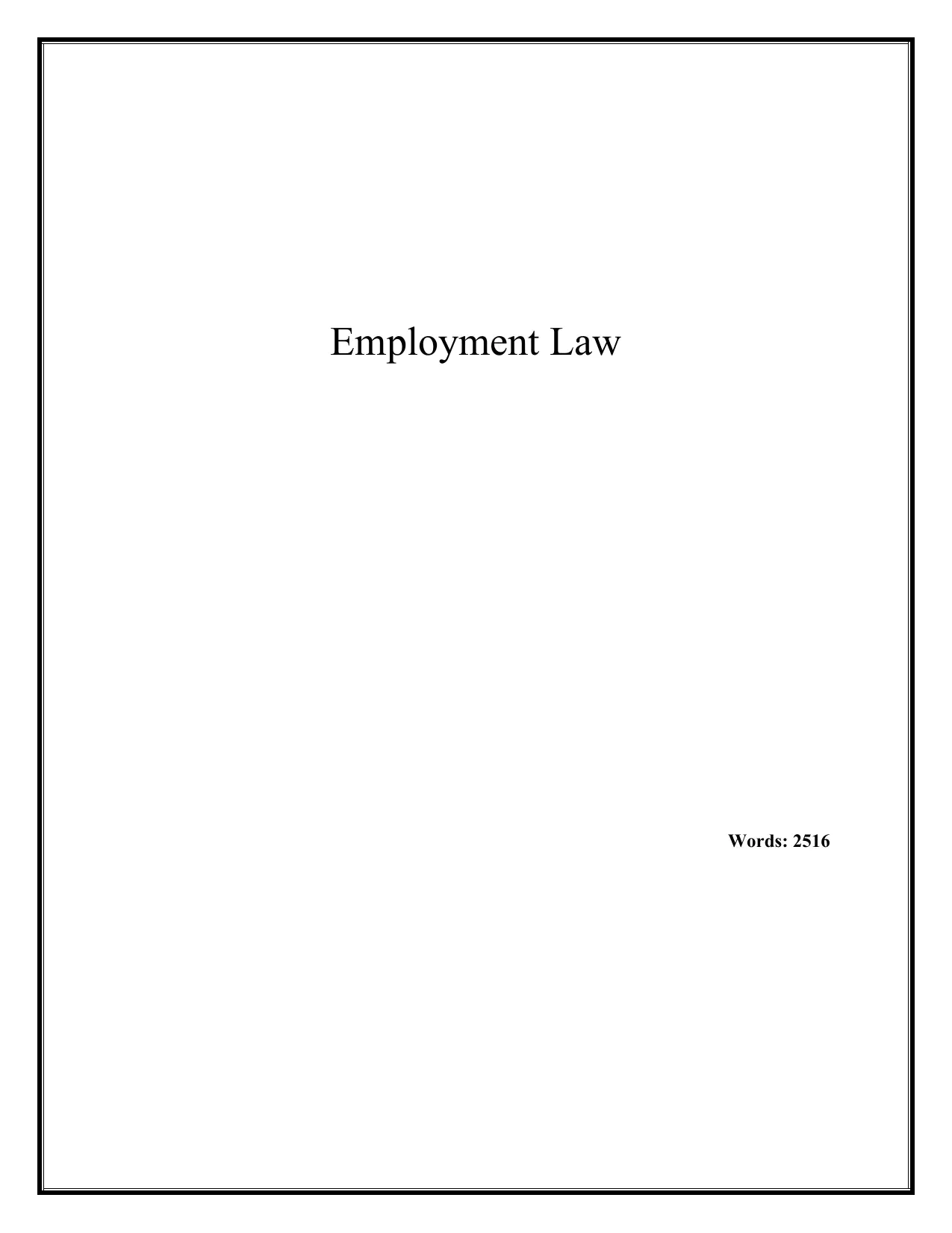
Employment Law
Words: 2516
Words: 2516
Paraphrase This Document
Need a fresh take? Get an instant paraphrase of this document with our AI Paraphraser
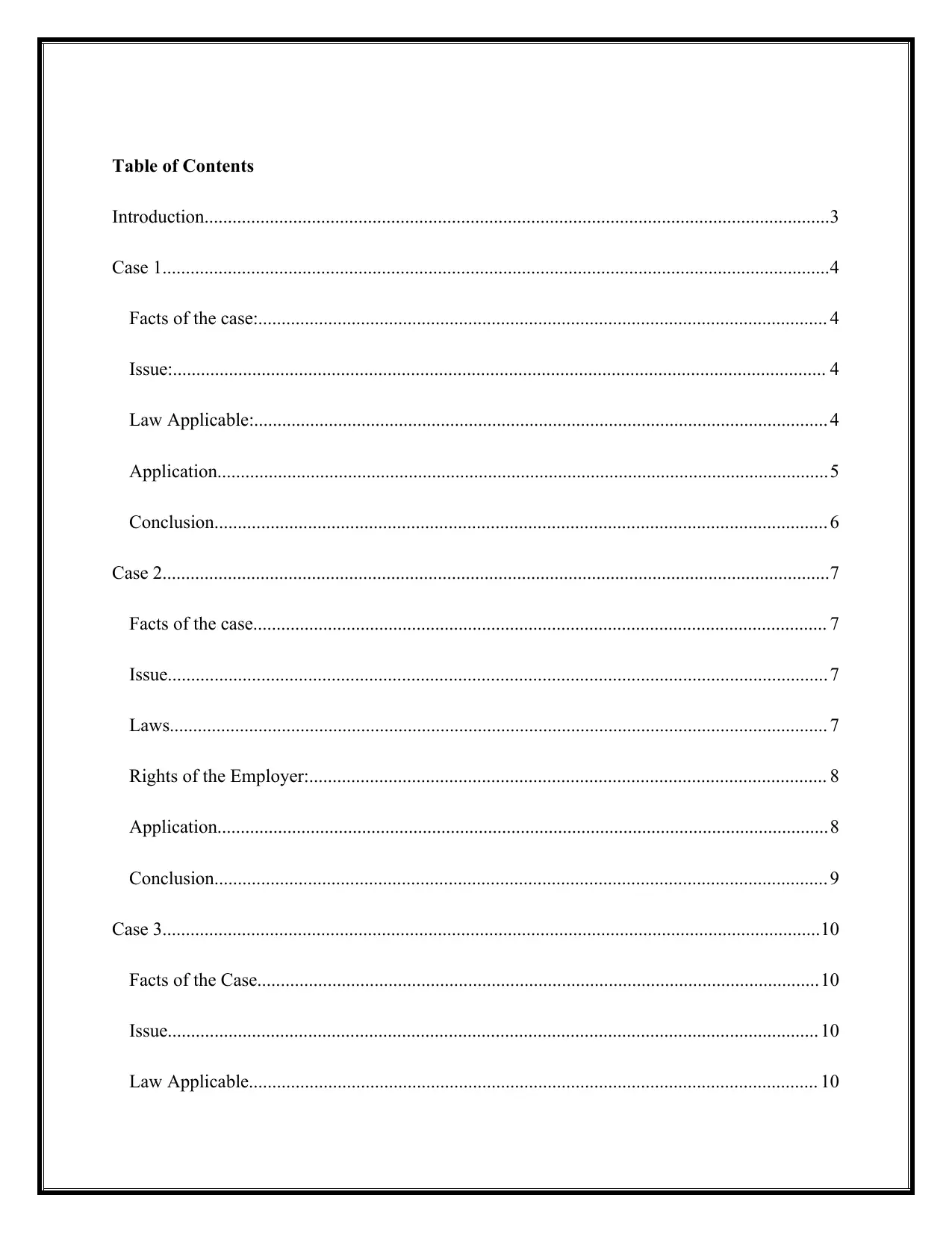
Table of Contents
Introduction......................................................................................................................................3
Case 1...............................................................................................................................................4
Facts of the case:.......................................................................................................................... 4
Issue:............................................................................................................................................ 4
Law Applicable:........................................................................................................................... 4
Application...................................................................................................................................5
Conclusion................................................................................................................................... 6
Case 2...............................................................................................................................................7
Facts of the case........................................................................................................................... 7
Issue............................................................................................................................................. 7
Laws............................................................................................................................................. 7
Rights of the Employer:............................................................................................................... 8
Application...................................................................................................................................8
Conclusion................................................................................................................................... 9
Case 3.............................................................................................................................................10
Facts of the Case........................................................................................................................10
Issue........................................................................................................................................... 10
Law Applicable.......................................................................................................................... 10
Introduction......................................................................................................................................3
Case 1...............................................................................................................................................4
Facts of the case:.......................................................................................................................... 4
Issue:............................................................................................................................................ 4
Law Applicable:........................................................................................................................... 4
Application...................................................................................................................................5
Conclusion................................................................................................................................... 6
Case 2...............................................................................................................................................7
Facts of the case........................................................................................................................... 7
Issue............................................................................................................................................. 7
Laws............................................................................................................................................. 7
Rights of the Employer:............................................................................................................... 8
Application...................................................................................................................................8
Conclusion................................................................................................................................... 9
Case 3.............................................................................................................................................10
Facts of the Case........................................................................................................................10
Issue........................................................................................................................................... 10
Law Applicable.......................................................................................................................... 10
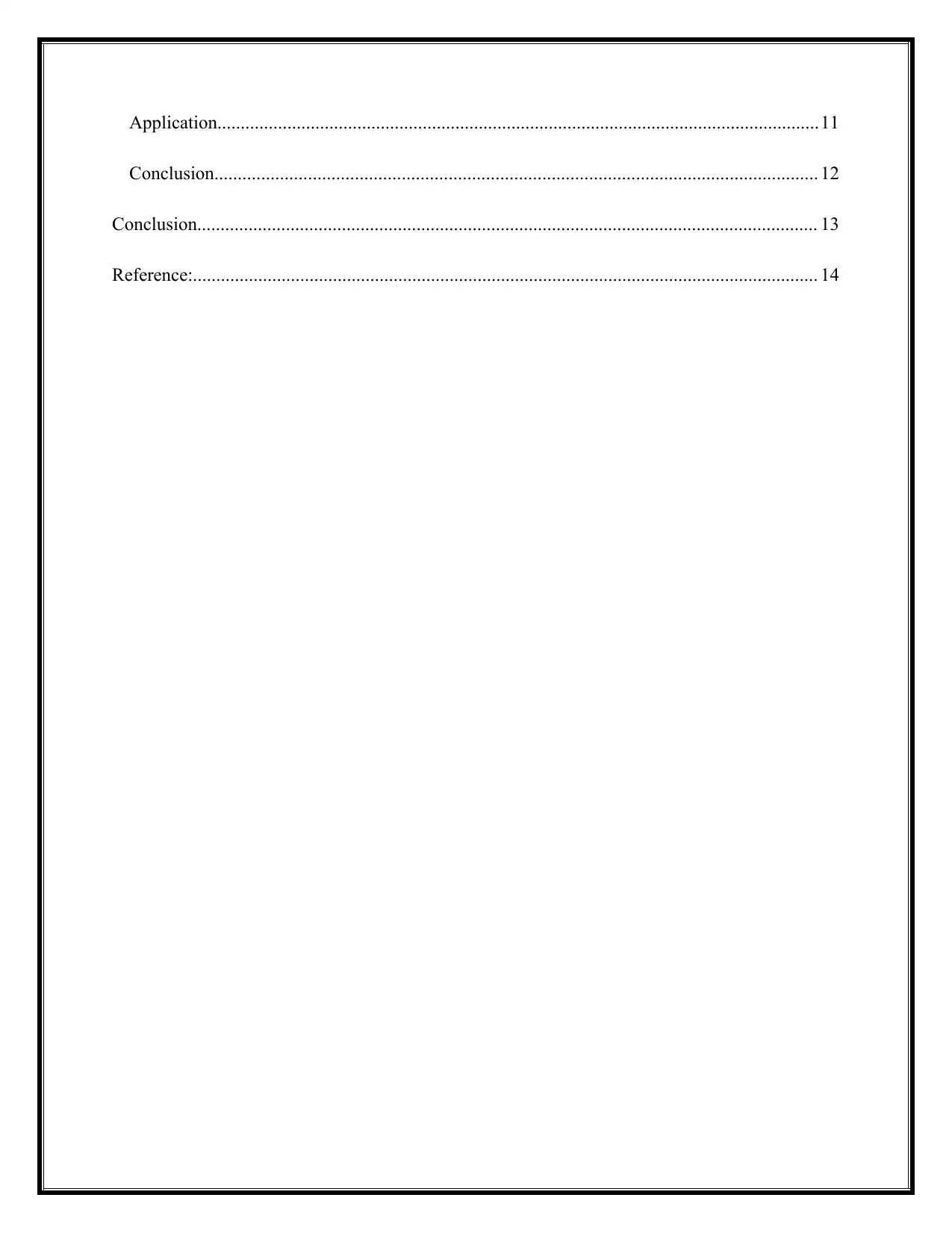
Application.................................................................................................................................11
Conclusion................................................................................................................................. 12
Conclusion..................................................................................................................................... 13
Reference:...................................................................................................................................... 14
Conclusion................................................................................................................................. 12
Conclusion..................................................................................................................................... 13
Reference:...................................................................................................................................... 14
⊘ This is a preview!⊘
Do you want full access?
Subscribe today to unlock all pages.

Trusted by 1+ million students worldwide
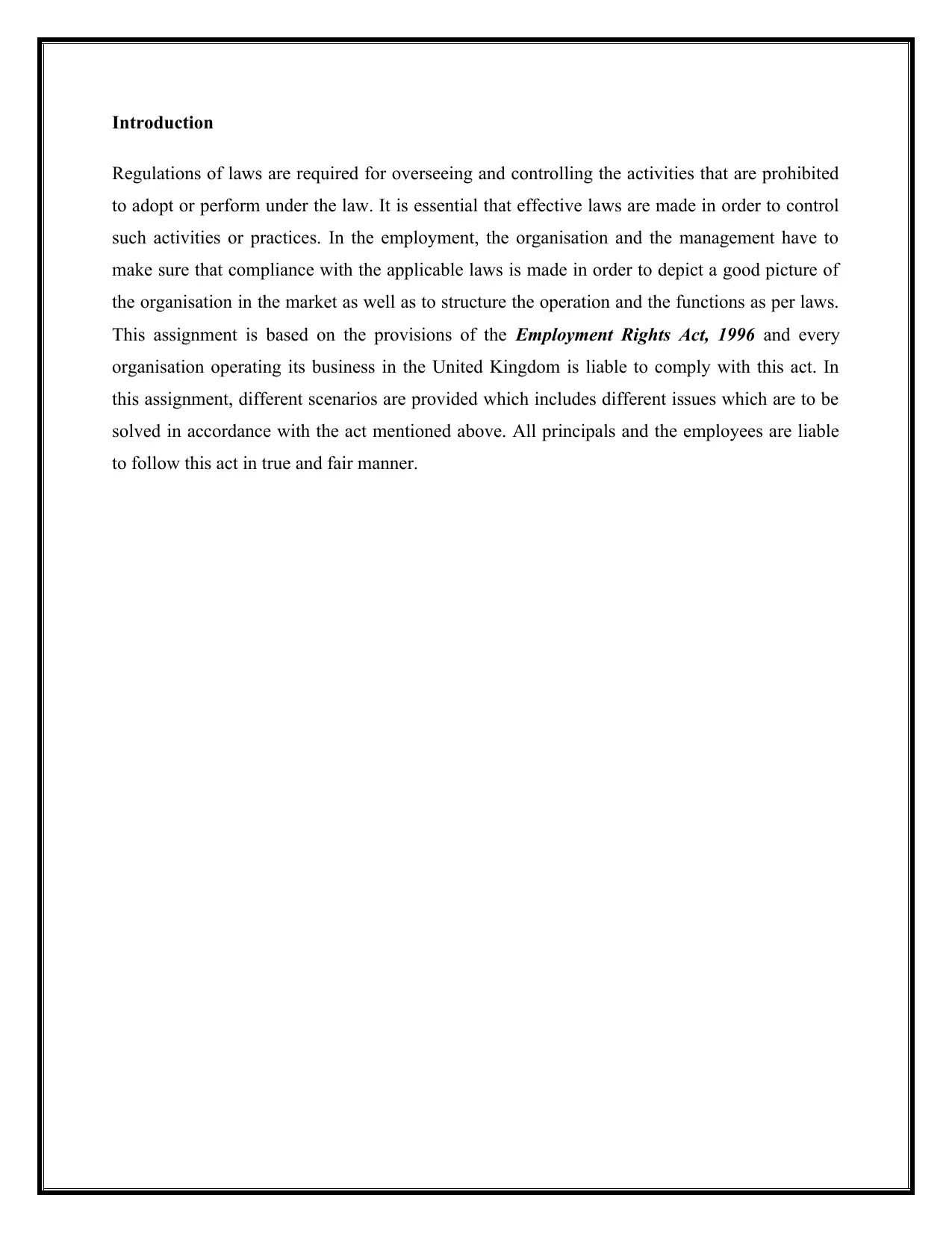
Introduction
Regulations of laws are required for overseeing and controlling the activities that are prohibited
to adopt or perform under the law. It is essential that effective laws are made in order to control
such activities or practices. In the employment, the organisation and the management have to
make sure that compliance with the applicable laws is made in order to depict a good picture of
the organisation in the market as well as to structure the operation and the functions as per laws.
This assignment is based on the provisions of the Employment Rights Act, 1996 and every
organisation operating its business in the United Kingdom is liable to comply with this act. In
this assignment, different scenarios are provided which includes different issues which are to be
solved in accordance with the act mentioned above. All principals and the employees are liable
to follow this act in true and fair manner.
Regulations of laws are required for overseeing and controlling the activities that are prohibited
to adopt or perform under the law. It is essential that effective laws are made in order to control
such activities or practices. In the employment, the organisation and the management have to
make sure that compliance with the applicable laws is made in order to depict a good picture of
the organisation in the market as well as to structure the operation and the functions as per laws.
This assignment is based on the provisions of the Employment Rights Act, 1996 and every
organisation operating its business in the United Kingdom is liable to comply with this act. In
this assignment, different scenarios are provided which includes different issues which are to be
solved in accordance with the act mentioned above. All principals and the employees are liable
to follow this act in true and fair manner.
Paraphrase This Document
Need a fresh take? Get an instant paraphrase of this document with our AI Paraphraser
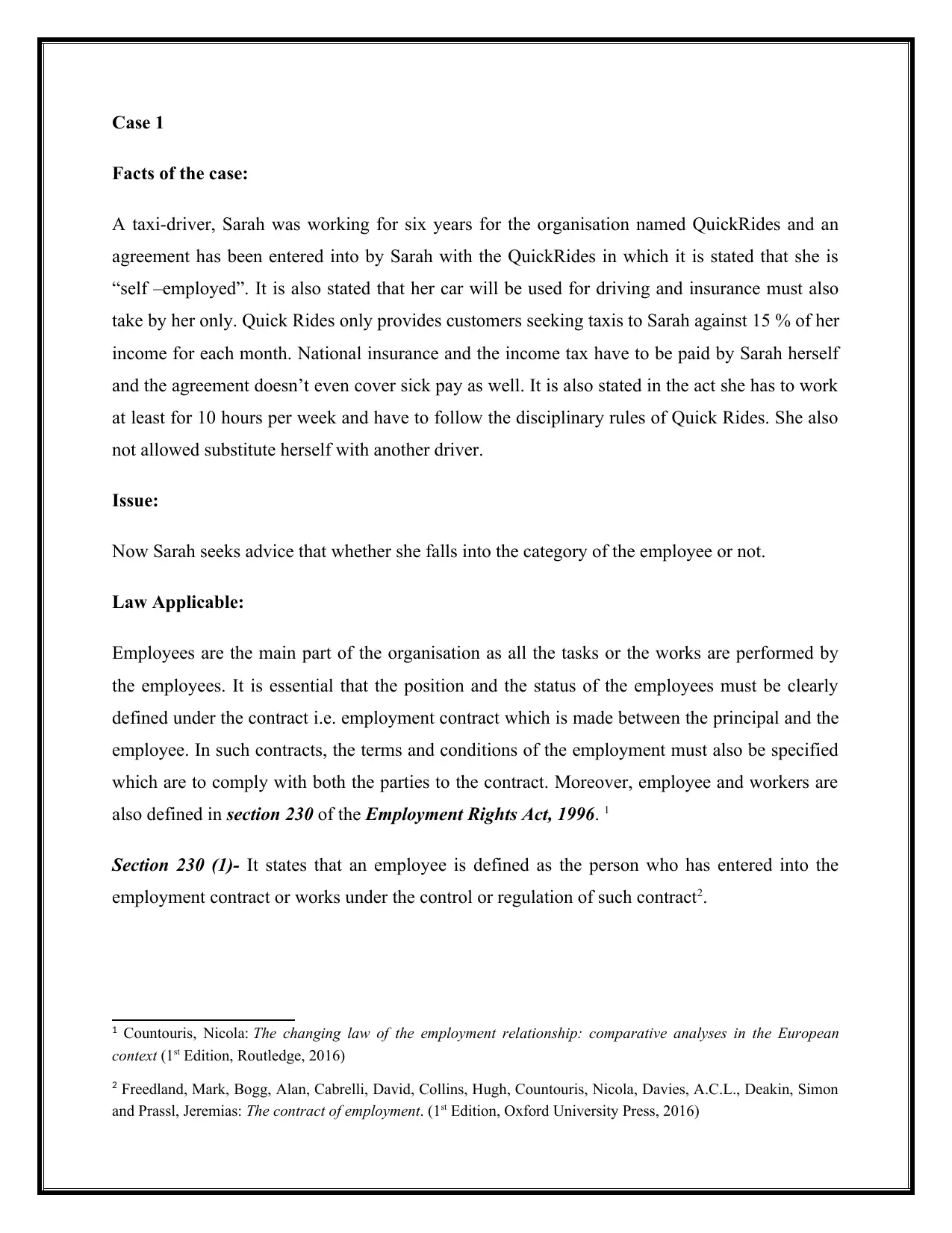
Case 1
Facts of the case:
A taxi-driver, Sarah was working for six years for the organisation named QuickRides and an
agreement has been entered into by Sarah with the QuickRides in which it is stated that she is
“self –employed”. It is also stated that her car will be used for driving and insurance must also
take by her only. Quick Rides only provides customers seeking taxis to Sarah against 15 % of her
income for each month. National insurance and the income tax have to be paid by Sarah herself
and the agreement doesn’t even cover sick pay as well. It is also stated in the act she has to work
at least for 10 hours per week and have to follow the disciplinary rules of Quick Rides. She also
not allowed substitute herself with another driver.
Issue:
Now Sarah seeks advice that whether she falls into the category of the employee or not.
Law Applicable:
Employees are the main part of the organisation as all the tasks or the works are performed by
the employees. It is essential that the position and the status of the employees must be clearly
defined under the contract i.e. employment contract which is made between the principal and the
employee. In such contracts, the terms and conditions of the employment must also be specified
which are to comply with both the parties to the contract. Moreover, employee and workers are
also defined in section 230 of the Employment Rights Act, 1996. 1
Section 230 (1)- It states that an employee is defined as the person who has entered into the
employment contract or works under the control or regulation of such contract2.
1 Countouris, Nicola: The changing law of the employment relationship: comparative analyses in the European
context (1st Edition, Routledge, 2016)
2 Freedland, Mark, Bogg, Alan, Cabrelli, David, Collins, Hugh, Countouris, Nicola, Davies, A.C.L., Deakin, Simon
and Prassl, Jeremias: The contract of employment. (1st Edition, Oxford University Press, 2016)
Facts of the case:
A taxi-driver, Sarah was working for six years for the organisation named QuickRides and an
agreement has been entered into by Sarah with the QuickRides in which it is stated that she is
“self –employed”. It is also stated that her car will be used for driving and insurance must also
take by her only. Quick Rides only provides customers seeking taxis to Sarah against 15 % of her
income for each month. National insurance and the income tax have to be paid by Sarah herself
and the agreement doesn’t even cover sick pay as well. It is also stated in the act she has to work
at least for 10 hours per week and have to follow the disciplinary rules of Quick Rides. She also
not allowed substitute herself with another driver.
Issue:
Now Sarah seeks advice that whether she falls into the category of the employee or not.
Law Applicable:
Employees are the main part of the organisation as all the tasks or the works are performed by
the employees. It is essential that the position and the status of the employees must be clearly
defined under the contract i.e. employment contract which is made between the principal and the
employee. In such contracts, the terms and conditions of the employment must also be specified
which are to comply with both the parties to the contract. Moreover, employee and workers are
also defined in section 230 of the Employment Rights Act, 1996. 1
Section 230 (1)- It states that an employee is defined as the person who has entered into the
employment contract or works under the control or regulation of such contract2.
1 Countouris, Nicola: The changing law of the employment relationship: comparative analyses in the European
context (1st Edition, Routledge, 2016)
2 Freedland, Mark, Bogg, Alan, Cabrelli, David, Collins, Hugh, Countouris, Nicola, Davies, A.C.L., Deakin, Simon
and Prassl, Jeremias: The contract of employment. (1st Edition, Oxford University Press, 2016)
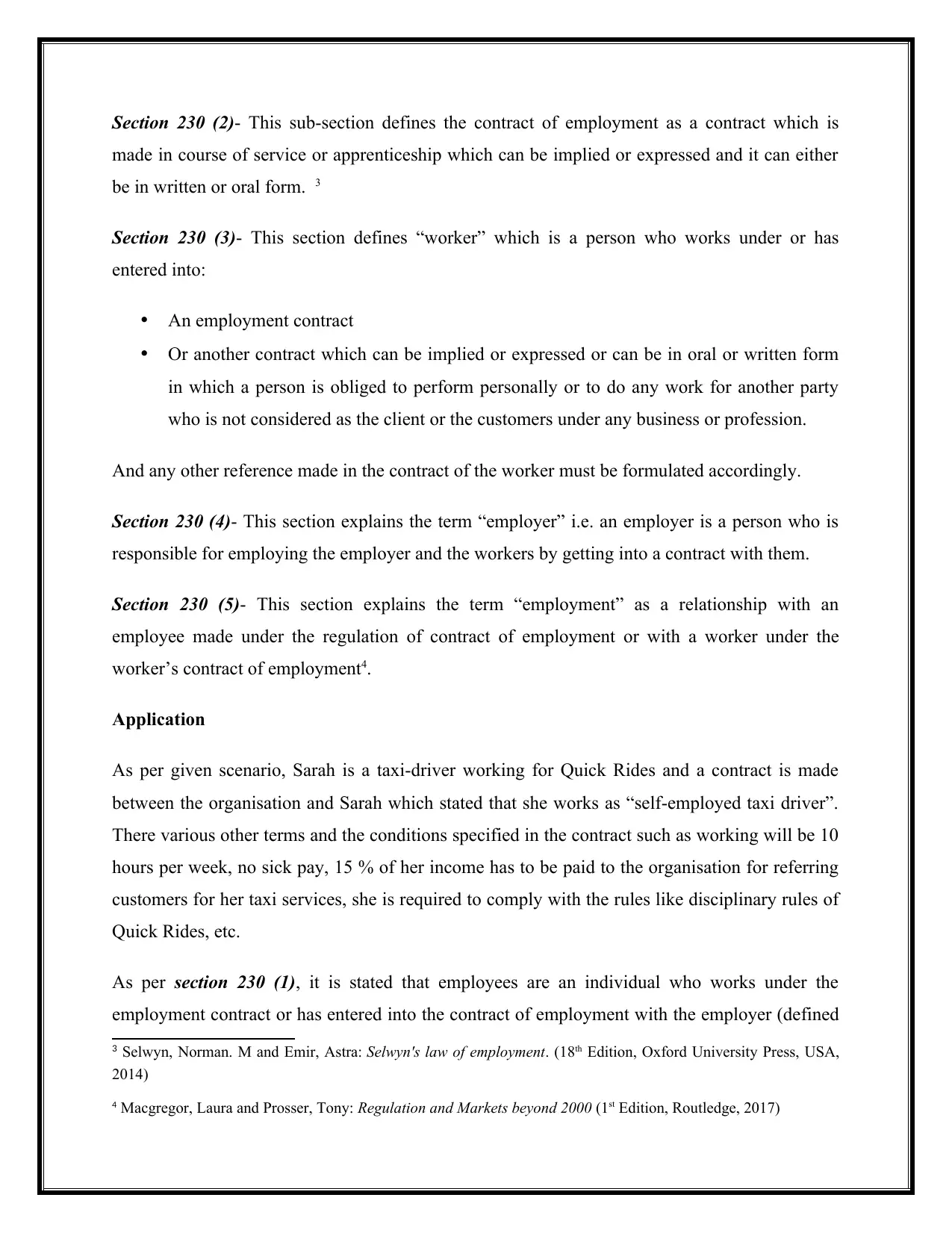
Section 230 (2)- This sub-section defines the contract of employment as a contract which is
made in course of service or apprenticeship which can be implied or expressed and it can either
be in written or oral form. 3
Section 230 (3)- This section defines “worker” which is a person who works under or has
entered into:
An employment contract
Or another contract which can be implied or expressed or can be in oral or written form
in which a person is obliged to perform personally or to do any work for another party
who is not considered as the client or the customers under any business or profession.
And any other reference made in the contract of the worker must be formulated accordingly.
Section 230 (4)- This section explains the term “employer” i.e. an employer is a person who is
responsible for employing the employer and the workers by getting into a contract with them.
Section 230 (5)- This section explains the term “employment” as a relationship with an
employee made under the regulation of contract of employment or with a worker under the
worker’s contract of employment4.
Application
As per given scenario, Sarah is a taxi-driver working for Quick Rides and a contract is made
between the organisation and Sarah which stated that she works as “self-employed taxi driver”.
There various other terms and the conditions specified in the contract such as working will be 10
hours per week, no sick pay, 15 % of her income has to be paid to the organisation for referring
customers for her taxi services, she is required to comply with the rules like disciplinary rules of
Quick Rides, etc.
As per section 230 (1), it is stated that employees are an individual who works under the
employment contract or has entered into the contract of employment with the employer (defined
3 Selwyn, Norman. M and Emir, Astra: Selwyn's law of employment. (18th Edition, Oxford University Press, USA,
2014)
4 Macgregor, Laura and Prosser, Tony: Regulation and Markets beyond 2000 (1st Edition, Routledge, 2017)
made in course of service or apprenticeship which can be implied or expressed and it can either
be in written or oral form. 3
Section 230 (3)- This section defines “worker” which is a person who works under or has
entered into:
An employment contract
Or another contract which can be implied or expressed or can be in oral or written form
in which a person is obliged to perform personally or to do any work for another party
who is not considered as the client or the customers under any business or profession.
And any other reference made in the contract of the worker must be formulated accordingly.
Section 230 (4)- This section explains the term “employer” i.e. an employer is a person who is
responsible for employing the employer and the workers by getting into a contract with them.
Section 230 (5)- This section explains the term “employment” as a relationship with an
employee made under the regulation of contract of employment or with a worker under the
worker’s contract of employment4.
Application
As per given scenario, Sarah is a taxi-driver working for Quick Rides and a contract is made
between the organisation and Sarah which stated that she works as “self-employed taxi driver”.
There various other terms and the conditions specified in the contract such as working will be 10
hours per week, no sick pay, 15 % of her income has to be paid to the organisation for referring
customers for her taxi services, she is required to comply with the rules like disciplinary rules of
Quick Rides, etc.
As per section 230 (1), it is stated that employees are an individual who works under the
employment contract or has entered into the contract of employment with the employer (defined
3 Selwyn, Norman. M and Emir, Astra: Selwyn's law of employment. (18th Edition, Oxford University Press, USA,
2014)
4 Macgregor, Laura and Prosser, Tony: Regulation and Markets beyond 2000 (1st Edition, Routledge, 2017)
⊘ This is a preview!⊘
Do you want full access?
Subscribe today to unlock all pages.

Trusted by 1+ million students worldwide
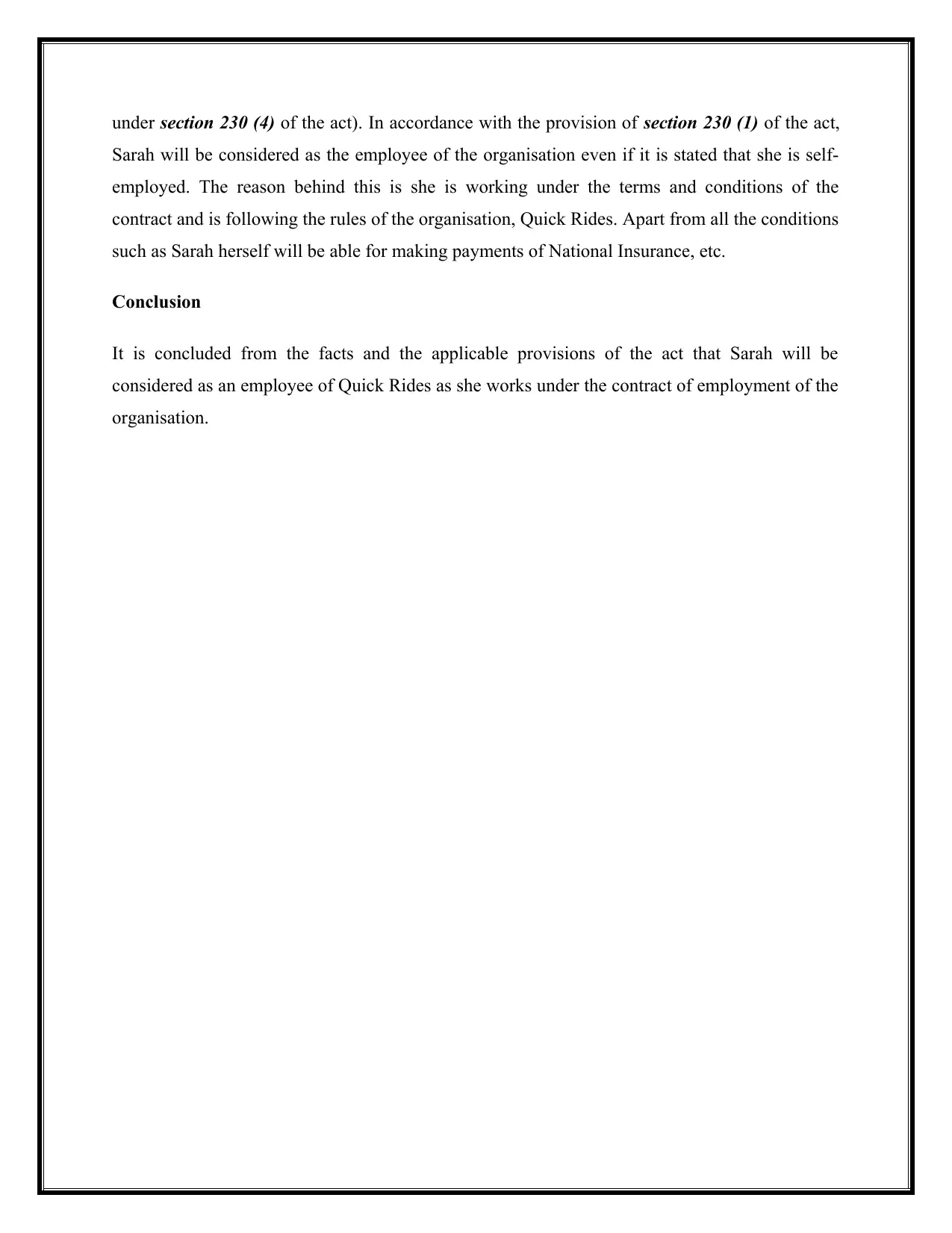
under section 230 (4) of the act). In accordance with the provision of section 230 (1) of the act,
Sarah will be considered as the employee of the organisation even if it is stated that she is self-
employed. The reason behind this is she is working under the terms and conditions of the
contract and is following the rules of the organisation, Quick Rides. Apart from all the conditions
such as Sarah herself will be able for making payments of National Insurance, etc.
Conclusion
It is concluded from the facts and the applicable provisions of the act that Sarah will be
considered as an employee of Quick Rides as she works under the contract of employment of the
organisation.
Sarah will be considered as the employee of the organisation even if it is stated that she is self-
employed. The reason behind this is she is working under the terms and conditions of the
contract and is following the rules of the organisation, Quick Rides. Apart from all the conditions
such as Sarah herself will be able for making payments of National Insurance, etc.
Conclusion
It is concluded from the facts and the applicable provisions of the act that Sarah will be
considered as an employee of Quick Rides as she works under the contract of employment of the
organisation.
Paraphrase This Document
Need a fresh take? Get an instant paraphrase of this document with our AI Paraphraser
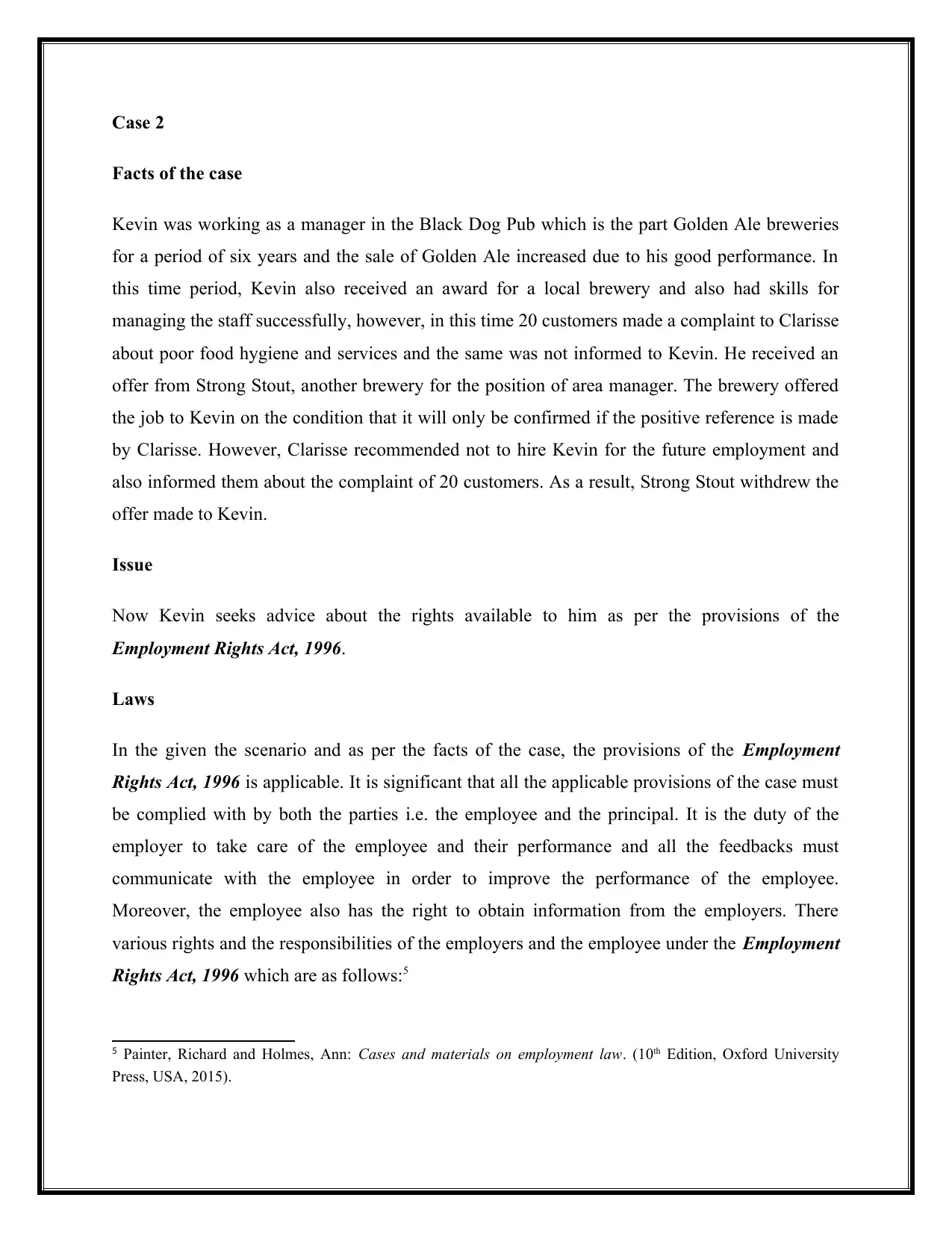
Case 2
Facts of the case
Kevin was working as a manager in the Black Dog Pub which is the part Golden Ale breweries
for a period of six years and the sale of Golden Ale increased due to his good performance. In
this time period, Kevin also received an award for a local brewery and also had skills for
managing the staff successfully, however, in this time 20 customers made a complaint to Clarisse
about poor food hygiene and services and the same was not informed to Kevin. He received an
offer from Strong Stout, another brewery for the position of area manager. The brewery offered
the job to Kevin on the condition that it will only be confirmed if the positive reference is made
by Clarisse. However, Clarisse recommended not to hire Kevin for the future employment and
also informed them about the complaint of 20 customers. As a result, Strong Stout withdrew the
offer made to Kevin.
Issue
Now Kevin seeks advice about the rights available to him as per the provisions of the
Employment Rights Act, 1996.
Laws
In the given the scenario and as per the facts of the case, the provisions of the Employment
Rights Act, 1996 is applicable. It is significant that all the applicable provisions of the case must
be complied with by both the parties i.e. the employee and the principal. It is the duty of the
employer to take care of the employee and their performance and all the feedbacks must
communicate with the employee in order to improve the performance of the employee.
Moreover, the employee also has the right to obtain information from the employers. There
various rights and the responsibilities of the employers and the employee under the Employment
Rights Act, 1996 which are as follows:5
5 Painter, Richard and Holmes, Ann: Cases and materials on employment law. (10th Edition, Oxford University
Press, USA, 2015).
Facts of the case
Kevin was working as a manager in the Black Dog Pub which is the part Golden Ale breweries
for a period of six years and the sale of Golden Ale increased due to his good performance. In
this time period, Kevin also received an award for a local brewery and also had skills for
managing the staff successfully, however, in this time 20 customers made a complaint to Clarisse
about poor food hygiene and services and the same was not informed to Kevin. He received an
offer from Strong Stout, another brewery for the position of area manager. The brewery offered
the job to Kevin on the condition that it will only be confirmed if the positive reference is made
by Clarisse. However, Clarisse recommended not to hire Kevin for the future employment and
also informed them about the complaint of 20 customers. As a result, Strong Stout withdrew the
offer made to Kevin.
Issue
Now Kevin seeks advice about the rights available to him as per the provisions of the
Employment Rights Act, 1996.
Laws
In the given the scenario and as per the facts of the case, the provisions of the Employment
Rights Act, 1996 is applicable. It is significant that all the applicable provisions of the case must
be complied with by both the parties i.e. the employee and the principal. It is the duty of the
employer to take care of the employee and their performance and all the feedbacks must
communicate with the employee in order to improve the performance of the employee.
Moreover, the employee also has the right to obtain information from the employers. There
various rights and the responsibilities of the employers and the employee under the Employment
Rights Act, 1996 which are as follows:5
5 Painter, Richard and Holmes, Ann: Cases and materials on employment law. (10th Edition, Oxford University
Press, USA, 2015).
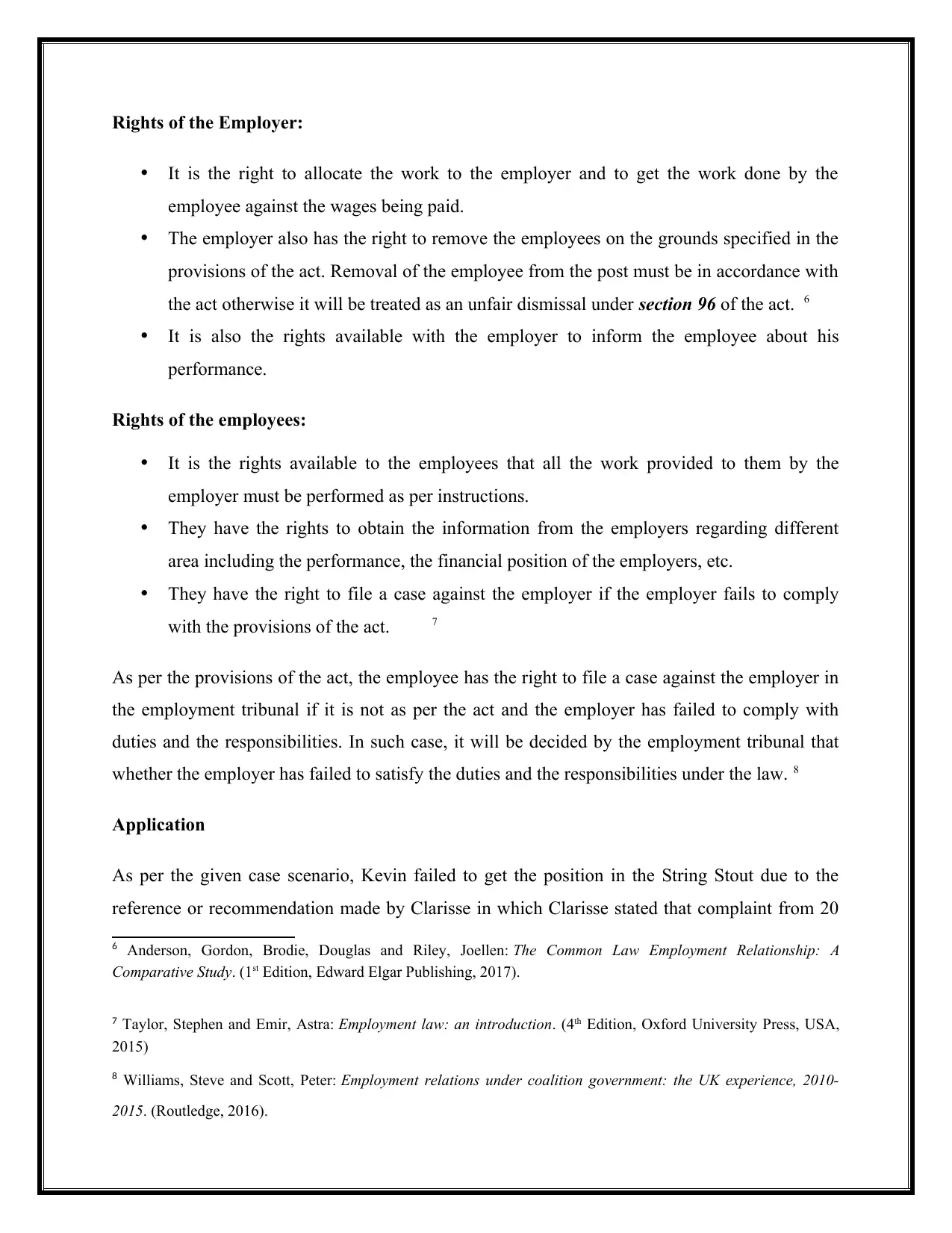
Rights of the Employer:
It is the right to allocate the work to the employer and to get the work done by the
employee against the wages being paid.
The employer also has the right to remove the employees on the grounds specified in the
provisions of the act. Removal of the employee from the post must be in accordance with
the act otherwise it will be treated as an unfair dismissal under section 96 of the act. 6
It is also the rights available with the employer to inform the employee about his
performance.
Rights of the employees:
It is the rights available to the employees that all the work provided to them by the
employer must be performed as per instructions.
They have the rights to obtain the information from the employers regarding different
area including the performance, the financial position of the employers, etc.
They have the right to file a case against the employer if the employer fails to comply
with the provisions of the act. 7
As per the provisions of the act, the employee has the right to file a case against the employer in
the employment tribunal if it is not as per the act and the employer has failed to comply with
duties and the responsibilities. In such case, it will be decided by the employment tribunal that
whether the employer has failed to satisfy the duties and the responsibilities under the law. 8
Application
As per the given case scenario, Kevin failed to get the position in the String Stout due to the
reference or recommendation made by Clarisse in which Clarisse stated that complaint from 20
6 Anderson, Gordon, Brodie, Douglas and Riley, Joellen: The Common Law Employment Relationship: A
Comparative Study. (1st Edition, Edward Elgar Publishing, 2017).
7 Taylor, Stephen and Emir, Astra: Employment law: an introduction. (4th Edition, Oxford University Press, USA,
2015)
8 Williams, Steve and Scott, Peter: Employment relations under coalition government: the UK experience, 2010-
2015. (Routledge, 2016).
It is the right to allocate the work to the employer and to get the work done by the
employee against the wages being paid.
The employer also has the right to remove the employees on the grounds specified in the
provisions of the act. Removal of the employee from the post must be in accordance with
the act otherwise it will be treated as an unfair dismissal under section 96 of the act. 6
It is also the rights available with the employer to inform the employee about his
performance.
Rights of the employees:
It is the rights available to the employees that all the work provided to them by the
employer must be performed as per instructions.
They have the rights to obtain the information from the employers regarding different
area including the performance, the financial position of the employers, etc.
They have the right to file a case against the employer if the employer fails to comply
with the provisions of the act. 7
As per the provisions of the act, the employee has the right to file a case against the employer in
the employment tribunal if it is not as per the act and the employer has failed to comply with
duties and the responsibilities. In such case, it will be decided by the employment tribunal that
whether the employer has failed to satisfy the duties and the responsibilities under the law. 8
Application
As per the given case scenario, Kevin failed to get the position in the String Stout due to the
reference or recommendation made by Clarisse in which Clarisse stated that complaint from 20
6 Anderson, Gordon, Brodie, Douglas and Riley, Joellen: The Common Law Employment Relationship: A
Comparative Study. (1st Edition, Edward Elgar Publishing, 2017).
7 Taylor, Stephen and Emir, Astra: Employment law: an introduction. (4th Edition, Oxford University Press, USA,
2015)
8 Williams, Steve and Scott, Peter: Employment relations under coalition government: the UK experience, 2010-
2015. (Routledge, 2016).
⊘ This is a preview!⊘
Do you want full access?
Subscribe today to unlock all pages.

Trusted by 1+ million students worldwide
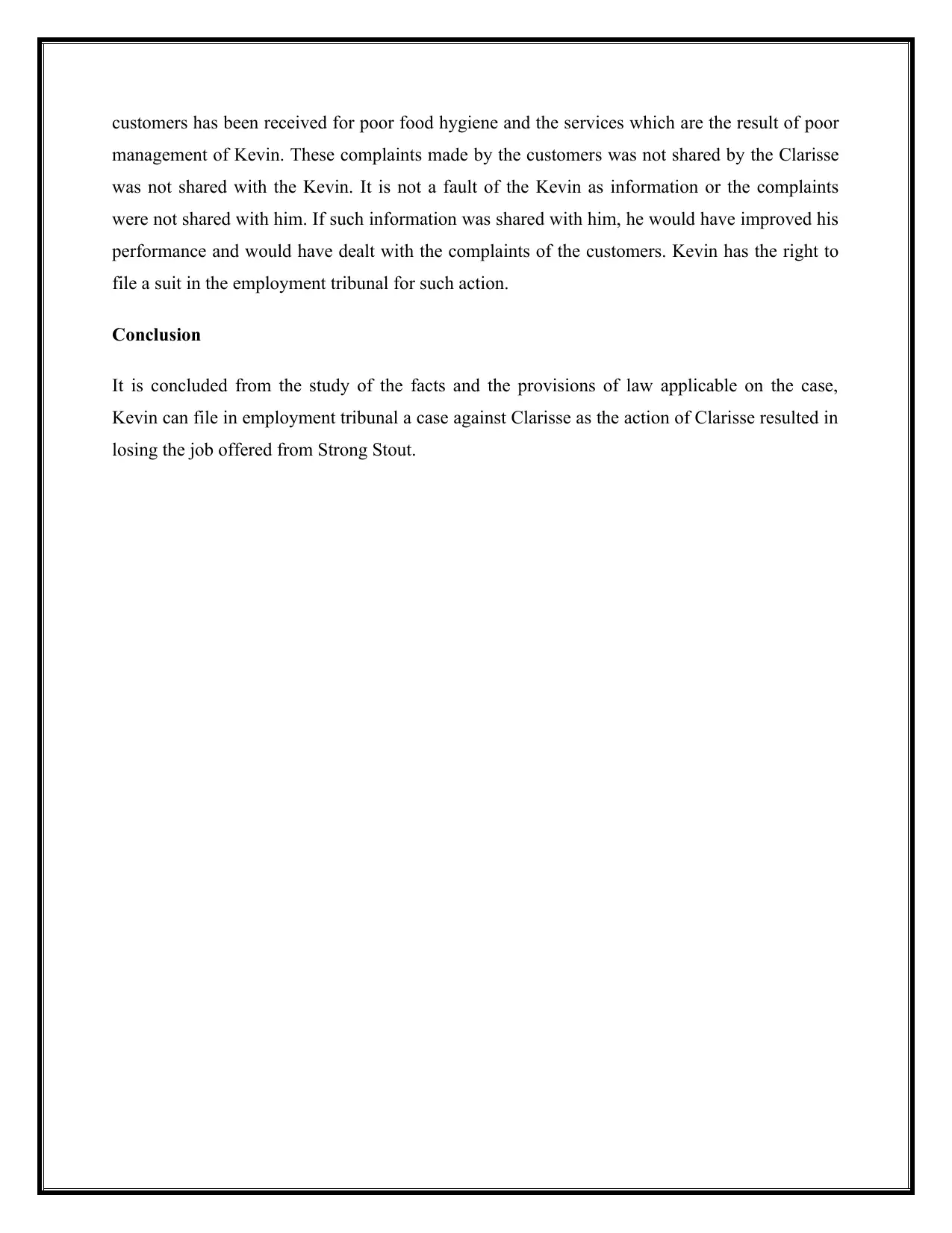
customers has been received for poor food hygiene and the services which are the result of poor
management of Kevin. These complaints made by the customers was not shared by the Clarisse
was not shared with the Kevin. It is not a fault of the Kevin as information or the complaints
were not shared with him. If such information was shared with him, he would have improved his
performance and would have dealt with the complaints of the customers. Kevin has the right to
file a suit in the employment tribunal for such action.
Conclusion
It is concluded from the study of the facts and the provisions of law applicable on the case,
Kevin can file in employment tribunal a case against Clarisse as the action of Clarisse resulted in
losing the job offered from Strong Stout.
management of Kevin. These complaints made by the customers was not shared by the Clarisse
was not shared with the Kevin. It is not a fault of the Kevin as information or the complaints
were not shared with him. If such information was shared with him, he would have improved his
performance and would have dealt with the complaints of the customers. Kevin has the right to
file a suit in the employment tribunal for such action.
Conclusion
It is concluded from the study of the facts and the provisions of law applicable on the case,
Kevin can file in employment tribunal a case against Clarisse as the action of Clarisse resulted in
losing the job offered from Strong Stout.
Paraphrase This Document
Need a fresh take? Get an instant paraphrase of this document with our AI Paraphraser
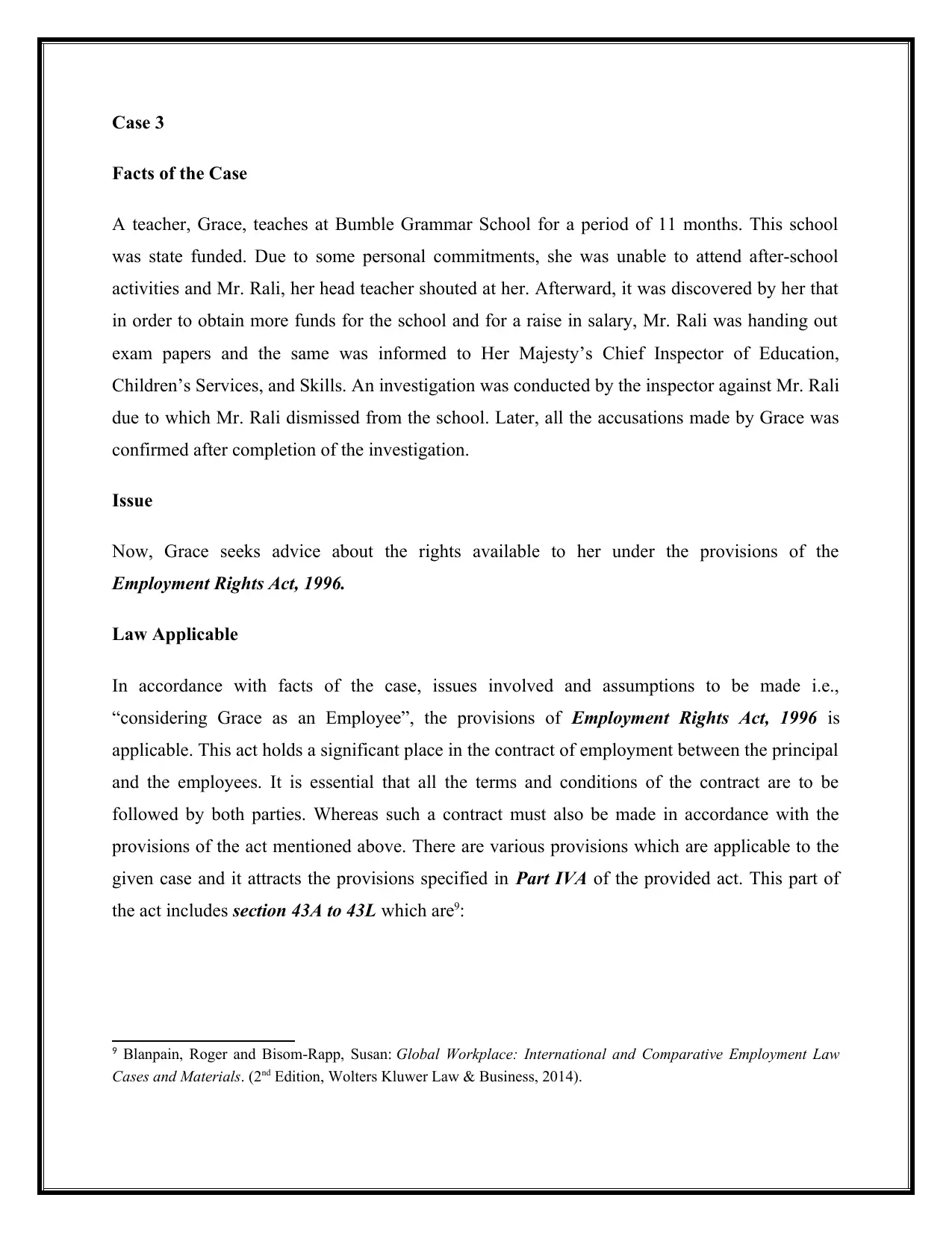
Case 3
Facts of the Case
A teacher, Grace, teaches at Bumble Grammar School for a period of 11 months. This school
was state funded. Due to some personal commitments, she was unable to attend after-school
activities and Mr. Rali, her head teacher shouted at her. Afterward, it was discovered by her that
in order to obtain more funds for the school and for a raise in salary, Mr. Rali was handing out
exam papers and the same was informed to Her Majesty’s Chief Inspector of Education,
Children’s Services, and Skills. An investigation was conducted by the inspector against Mr. Rali
due to which Mr. Rali dismissed from the school. Later, all the accusations made by Grace was
confirmed after completion of the investigation.
Issue
Now, Grace seeks advice about the rights available to her under the provisions of the
Employment Rights Act, 1996.
Law Applicable
In accordance with facts of the case, issues involved and assumptions to be made i.e.,
“considering Grace as an Employee”, the provisions of Employment Rights Act, 1996 is
applicable. This act holds a significant place in the contract of employment between the principal
and the employees. It is essential that all the terms and conditions of the contract are to be
followed by both parties. Whereas such a contract must also be made in accordance with the
provisions of the act mentioned above. There are various provisions which are applicable to the
given case and it attracts the provisions specified in Part IVA of the provided act. This part of
the act includes section 43A to 43L which are9:
9 Blanpain, Roger and Bisom-Rapp, Susan: Global Workplace: International and Comparative Employment Law
Cases and Materials. (2nd Edition, Wolters Kluwer Law & Business, 2014).
Facts of the Case
A teacher, Grace, teaches at Bumble Grammar School for a period of 11 months. This school
was state funded. Due to some personal commitments, she was unable to attend after-school
activities and Mr. Rali, her head teacher shouted at her. Afterward, it was discovered by her that
in order to obtain more funds for the school and for a raise in salary, Mr. Rali was handing out
exam papers and the same was informed to Her Majesty’s Chief Inspector of Education,
Children’s Services, and Skills. An investigation was conducted by the inspector against Mr. Rali
due to which Mr. Rali dismissed from the school. Later, all the accusations made by Grace was
confirmed after completion of the investigation.
Issue
Now, Grace seeks advice about the rights available to her under the provisions of the
Employment Rights Act, 1996.
Law Applicable
In accordance with facts of the case, issues involved and assumptions to be made i.e.,
“considering Grace as an Employee”, the provisions of Employment Rights Act, 1996 is
applicable. This act holds a significant place in the contract of employment between the principal
and the employees. It is essential that all the terms and conditions of the contract are to be
followed by both parties. Whereas such a contract must also be made in accordance with the
provisions of the act mentioned above. There are various provisions which are applicable to the
given case and it attracts the provisions specified in Part IVA of the provided act. This part of
the act includes section 43A to 43L which are9:
9 Blanpain, Roger and Bisom-Rapp, Susan: Global Workplace: International and Comparative Employment Law
Cases and Materials. (2nd Edition, Wolters Kluwer Law & Business, 2014).
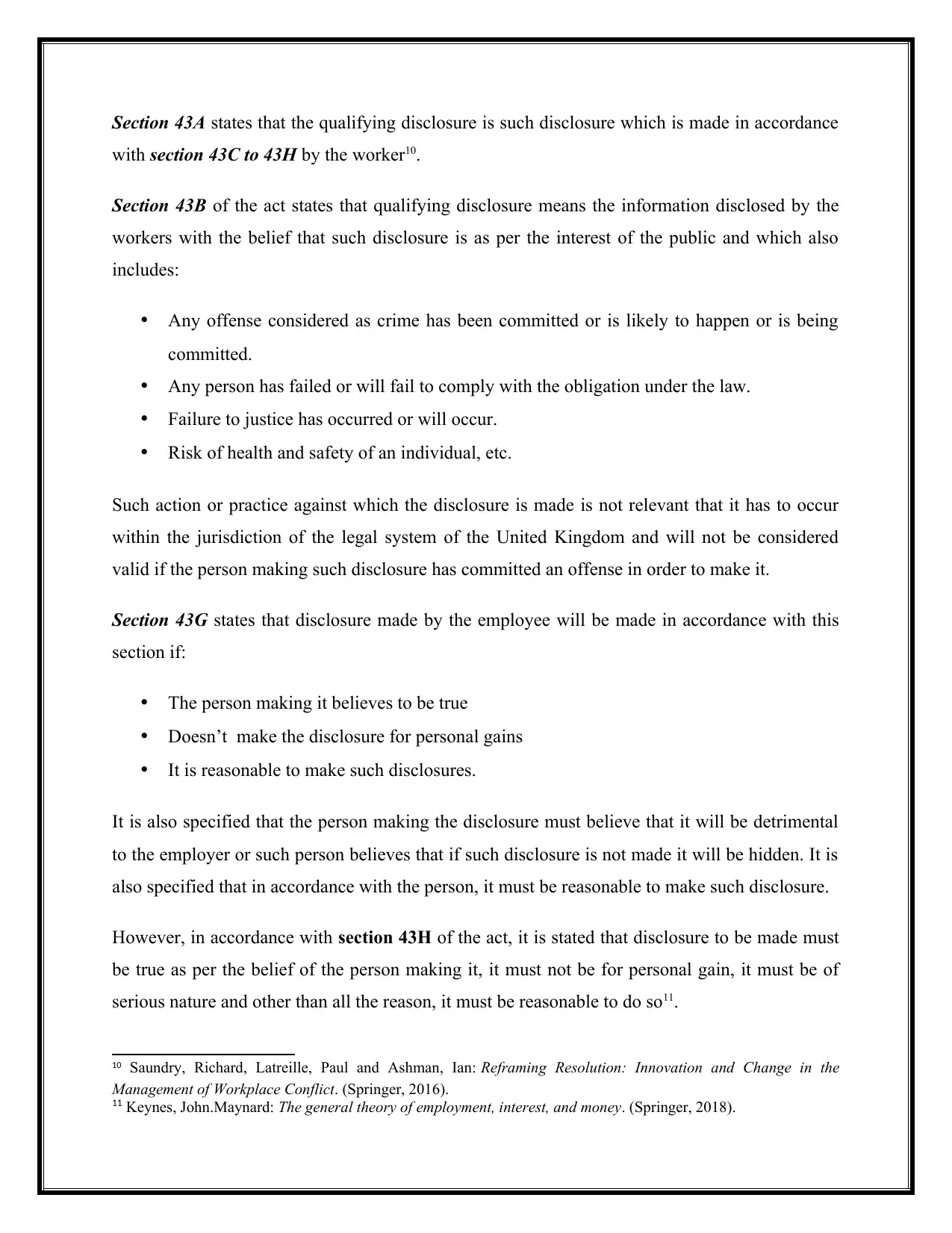
Section 43A states that the qualifying disclosure is such disclosure which is made in accordance
with section 43C to 43H by the worker10.
Section 43B of the act states that qualifying disclosure means the information disclosed by the
workers with the belief that such disclosure is as per the interest of the public and which also
includes:
Any offense considered as crime has been committed or is likely to happen or is being
committed.
Any person has failed or will fail to comply with the obligation under the law.
Failure to justice has occurred or will occur.
Risk of health and safety of an individual, etc.
Such action or practice against which the disclosure is made is not relevant that it has to occur
within the jurisdiction of the legal system of the United Kingdom and will not be considered
valid if the person making such disclosure has committed an offense in order to make it.
Section 43G states that disclosure made by the employee will be made in accordance with this
section if:
The person making it believes to be true
Doesn’t make the disclosure for personal gains
It is reasonable to make such disclosures.
It is also specified that the person making the disclosure must believe that it will be detrimental
to the employer or such person believes that if such disclosure is not made it will be hidden. It is
also specified that in accordance with the person, it must be reasonable to make such disclosure.
However, in accordance with section 43H of the act, it is stated that disclosure to be made must
be true as per the belief of the person making it, it must not be for personal gain, it must be of
serious nature and other than all the reason, it must be reasonable to do so11.
10 Saundry, Richard, Latreille, Paul and Ashman, Ian: Reframing Resolution: Innovation and Change in the
Management of Workplace Conflict. (Springer, 2016).
11 Keynes, John.Maynard: The general theory of employment, interest, and money. (Springer, 2018).
with section 43C to 43H by the worker10.
Section 43B of the act states that qualifying disclosure means the information disclosed by the
workers with the belief that such disclosure is as per the interest of the public and which also
includes:
Any offense considered as crime has been committed or is likely to happen or is being
committed.
Any person has failed or will fail to comply with the obligation under the law.
Failure to justice has occurred or will occur.
Risk of health and safety of an individual, etc.
Such action or practice against which the disclosure is made is not relevant that it has to occur
within the jurisdiction of the legal system of the United Kingdom and will not be considered
valid if the person making such disclosure has committed an offense in order to make it.
Section 43G states that disclosure made by the employee will be made in accordance with this
section if:
The person making it believes to be true
Doesn’t make the disclosure for personal gains
It is reasonable to make such disclosures.
It is also specified that the person making the disclosure must believe that it will be detrimental
to the employer or such person believes that if such disclosure is not made it will be hidden. It is
also specified that in accordance with the person, it must be reasonable to make such disclosure.
However, in accordance with section 43H of the act, it is stated that disclosure to be made must
be true as per the belief of the person making it, it must not be for personal gain, it must be of
serious nature and other than all the reason, it must be reasonable to do so11.
10 Saundry, Richard, Latreille, Paul and Ashman, Ian: Reframing Resolution: Innovation and Change in the
Management of Workplace Conflict. (Springer, 2016).
11 Keynes, John.Maynard: The general theory of employment, interest, and money. (Springer, 2018).
⊘ This is a preview!⊘
Do you want full access?
Subscribe today to unlock all pages.

Trusted by 1+ million students worldwide
1 out of 15
Related Documents
Your All-in-One AI-Powered Toolkit for Academic Success.
+13062052269
info@desklib.com
Available 24*7 on WhatsApp / Email
![[object Object]](/_next/static/media/star-bottom.7253800d.svg)
Unlock your academic potential
Copyright © 2020–2025 A2Z Services. All Rights Reserved. Developed and managed by ZUCOL.



